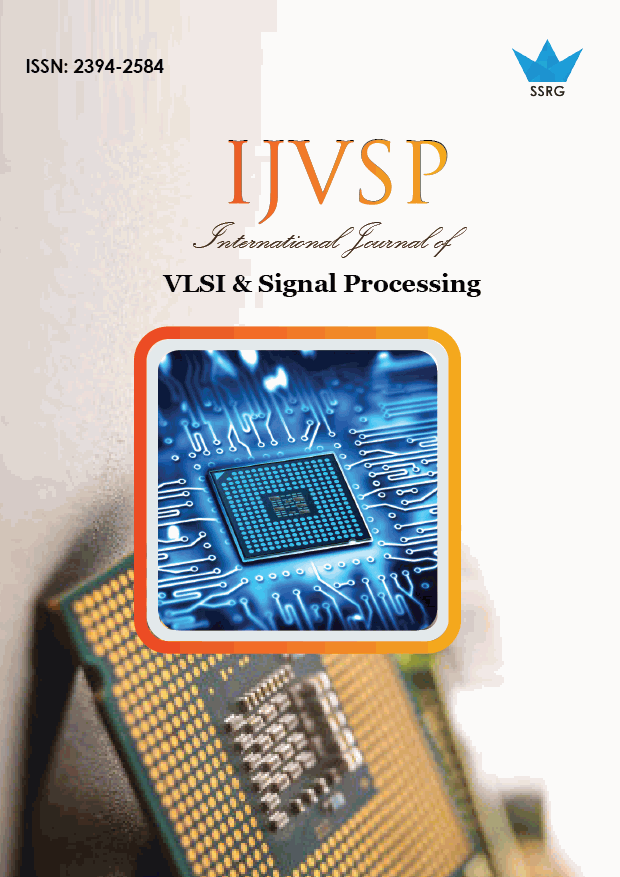Analysis and Optimization of a Floating Point Representation of a Complex Numbers using FPGA

| International Journal of VLSI & Signal Processing |
| © 2016 by SSRG - IJVSP Journal |
| Volume 3 Issue 2 |
| Year of Publication : 2016 |
| Authors : Dr.A.Nitesh and J.Deveesh |
How to Cite?
Dr.A.Nitesh and J.Deveesh, "Analysis and Optimization of a Floating Point Representation of a Complex Numbers using FPGA," SSRG International Journal of VLSI & Signal Processing, vol. 3, no. 2, pp. 17-21, 2016. Crossref, https://doi.org/10.14445/23942584/IJVSP-V3I2P104
Abstract:
A quad-core processoris achip with four autonomouscomponents called cores whichdeliver and accomplish central processing unit. The quad processor core is an emerging trend used in many systematic and industrialclaims. In a distinct programmable device, FPGA with improving performance and gate capability can be implemented. The diplomatic issues in the embedded multiprocessor are thread safety. They have been occurred by the shared memory;while a thread safety is disrupted the processors could able to deliberate the equivalent value at the identical time. The two main impacts such as clock scaling procedures and micro architectural improvements are used to improve the processor performance. Consequentlyto rectify this problem, a new phenomenon called quad core architecture has been developed for system on a chip solicitation. Hence this system is designed by using VHDL and it accomplishesaninstantaneoususage of both parallel and distributed networks. The operations such as arithmetic, logical, shifting and bit manipulate are deliberated by using the full architecture of quad core processor. The projected quad processor core comprisesStandardized RISC processorsextracted with pipelined handlingcomponents, multi bus organization and I/O ports alongside with furtherefficientfeaturesnecessary to design embedded SoCresults. The implemented Quad core presentationdisputes such as speed, area, and power dissipation.
Keywords:
complex floating points, arithmetic and logic operations, IEEE 754 standard, complex arithmetic unit, instruction set.
References:
[1]A.Beaumont Smith, N.Burgess, S.Lefrere, and C.C.Lim,―Reduced latency IEEE floating-point standard ladder architectures, inProc. IEEE Symp. Comput. Arithmetic, 1999, pp. 35–42.
[2] P. S. Paolucci, ―Complex Domain Floating Point VLIW DSP with Data/Program Bus Multiplexer and Microprocessor Interface, U.S. Patent 7 437 540, Oct. 14, 2008.
[3] Dake Liu ―Embedded DSP Processor Design application specific instruction set processors, ELSEVIER.
[4] S. Katayanagi, ―Complex Vector Operation Processor with Pipeline Processing Function and System Using the Same, U.S. Patent 20030009502, Jan. 9, 2003.
[5] ] C. Inacio and D. Ombres, ―The DSP decision: Fixed point or floating?, IEEE Spectrum, vol. 33, no.9, pp. 72–74, Sep. 1996.
[6] IEEE Standard for Floating-Point Arithmetic, IEEE Std 754- 2008, Aug. 29, 2008, pp. 1–58.
[7] Allison L. Walters, ―A Scalable FIR Filter Implementation Using 32-bit Floating-Point Complex Arithmetic on a FPGA Based Custom Computing Platform, M.S. thesis, Dept. Electrical. Eng., Virginia, 1998.
[8] R. G. Cox, M. W. Yeager, and L. L. Flake, ―Single Chip Complex Floating Point NumericProcessor, U.S. Patent 4996661, Feb. 26, 1991.
[9] Nadav Cohen and ShlomoWeiss, Complex Floating Point— A Novel Data Word Representation for DSP Processors‖ IEEE transactions on circuits and systems—I, VOL.59, no.10, pp.2252-2262 , oct2012.
[10] Mazen A. R. Saghir ―Application Specific Instruction-set architectures for embedded DSP Applications Ph.D thesis, Dept., of electrical and computer engineering, university of Toronto, canada.

 10.14445/23942584/IJVSP-V3I2P104
10.14445/23942584/IJVSP-V3I2P104